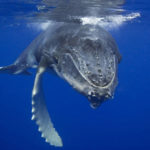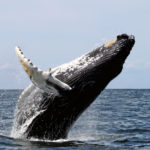Facts about killer whales
 Killer whale is the most dangerous predator of oceanic expanses. It can easily eat a sea lion or an elephant, and a whole family can easily cope with a 10-ton whale. For such an insidious disposition of killer whales even nicknamed whales-killers. But is it? This article will tell about these and other interesting facts about the killer whale.
Killer whale is the most dangerous predator of oceanic expanses. It can easily eat a sea lion or an elephant, and a whole family can easily cope with a 10-ton whale. For such an insidious disposition of killer whales even nicknamed whales-killers. But is it? This article will tell about these and other interesting facts about the killer whale.
- Killer whales are large predatory dolphins.
- Like dolphins, killer whales communicate with echolocation.
- Teeth at killer whales in length reach 13 cm, they allow you to easily rip the prey.
- Killer whales can reach speeds of up to 55 km / h.
- The shape of the spots is individual for each killer whale, with their help it is easy to distinguish one individual from another.
- In the northern part of the Pacific Ocean, one can meet whales of albinos (completely white) and killer whales (completely black).
- Each population has its own advantages in the choice of nutrition. Some killer whales eat fish, while others have mammals.
- Scientists divide kosatotok into two varieties: “transit” and “resident”, that is, the killer whale “vagabond” and “homebody”.
- Killer whales from one group behave very friendly towards each other. In the event of any disagreement, they express their discontent only by flapping the water with their fin or tail.
- In order not to die of hunger, killer whales need to eat from 50 to 200 kg of meat per day.
- Females in their entire life can give birth to 6 calves. In the period of 35-40 years, females lose the ability to bring offspring.
- In relation to man, the killer whale rarely shows aggression. In the wild, officially recorded cases of the killer whale attacks on humans were not.
- Recently, active activities have been conducted to prohibit the maintenance of killer whales in captivity. In the state of New York, USA, to keep killer whales in captivity is prohibited by law.
- Arctic killer whales, constantly living in cold waters, every year make a march to the warmer coasts of South America, and then return back. As scientists have suggested, they make the whole path for the sake of molting. During this process, the killer whales have a greater circulation, and heat loss also increases. Therefore, near the southern coast, where the water temperature is + 24 ° C, it is more convenient to kill killer whales.
- Scientists conducted an analysis of the genome of killer whales “homebodies” and “vagrants” and found that for 100 thousand years between these varieties there are no crossed crosses.
- The life expectancy of killer whales in males is 35 years on average and 50 years for females. Longevity was also recorded among females who lived 70-90 years.



























